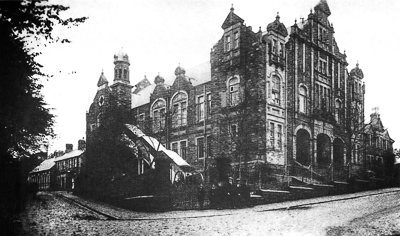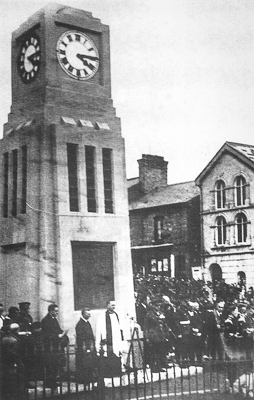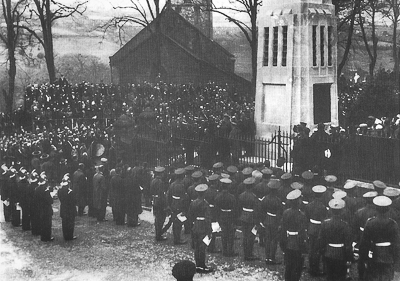Blaenavon War Memorial
The Blaenavon War Memorial Clock Tower stands outside The Working Mens Institute at the junction of High Street and Church Road, opposite the Church of St. Peter.
The memorial is surrounded by a low stone wall and decorative railings of wrought iron. Large double gates regulate direct access to the war memorial itself.
The four-faced, chiming clock tower, made of Portland Stone, was designed by R. L. Edmunds and constructed by Henry Evans. It occupies the same site that once displayed a souvenir from the Great War – a captured German field gun.

The Captured German Field Gun, on the Site of the Blaenavon War Memorial
The Blaenavon War Memorial was built to commemorate the local men who made the supreme sacrifice during the First World War. The stone tower and memorial cost in the order of £1,000, the money being raised by public and private subscription during a period of severe economic downturn in the area. The clock and the chimes cost in excess of £800, and, if it had not been for a donation from the Blaenavon Mines Benevolent Fund to cover these items, the war memorial may never have been completed.
A bronze plate, inset in the front face of the memorial reads:-
PRO PATRIA
IN PROUD AND GRATEFUL MEMORY OF THOSE MEN
OF BLAENAVON WHO, HAVING SUFFERED MANY HARDSHIPS
AND DANGERS FINALLY LAID DOWN THEIR LIVES IN THE
GREAT WAR 1914-1918.
THIS MEMORIAL IS ERECTED BY THE PEOPLE OF BLAENAVON
1931
In his book, First World War Graves and Memorials in Gwent – Volume 1, Ray Westlake states that ‘Blaenavon was the headquarters of ‘E’ Company, 2nd Battalion, Monmouthshire Regiment (Territorial Force)’
This plaque records 118 casualties of the Great War, 114 of which are recorded in three columns of 38, without rank or regiment and in alphabetical order:-
Column 1: R. Ackroyd, H. Allcock, C. Andrews, G. Archer, J. Bailey, N. J. Baker, T. Barnes, A. Birkin, R. Bisp, J. Bourne, C. C. Brown, A. E. Burchell, L. Caddick, F. Caines, B. Carey, C. Catley, R. Clark, N. Clothier(1), F. Cook, F. J. Cudbey(2), N. B. Dancey, T. D. Dancey, A. Dando, R. Daniel, A. Davies, J. Davies, J. H. Davies, A. Dirkin, J. E. Edmunds, E. J. Eilson(3), D. Falvey, A. Filer, J. Gibson, E. J. Goodall, W. Goodall, W. H. Goodwin, J. Griffiths, E. J. Gulliford(4).
(1) – Private Newton Clothier, Royal Welsh Fusiliers.
(2) – Name recorded on plaque differs from enlisted name: Corporal F. J. Cudby, 1946, 2nd Battalion Monmouthshire Regiment.
(3) – Name recorded on plaque differs from enlisted name: Private John Ernest Elson, 2140, 2nd Battalion Monmouthshire Regiment.
(4) – Edward Jenkin Gulliford, 2nd Battalion South Wales Borderers.
Column 2: E. Hadley, W. Hannaford, D. Harrington, G. Harris, W. Hart, A. Hill, J. Hill, W. J. Hill(5), D. Hirst, S. Holvey, W. G. Hopkins, I. J. Howells, W. Howells, D. J. Huish, R. Hurle, D. J. Jenkins, J. Jenkins, P. A. Jenkins, A. Jones, T. B. Jones, I. Jones(6), J. T. Jones, W. Jones, A. J. Kenvin, W. King, A. J. Lewis, E. Lewis(7), E. A. Lewis, G. Lewis, H. Lewis, J. Lewis, E. Matthews, D. Meredith, W. H. Miles, E. Morgan, T. H. Morgan, W. Morris, T. E. Nelmes.
(5) – William John Hill. Died at the age of 33 years.
(6) – Private Idris Jones, 126138, Labour Corps.
(7) – Bombardier Edward Lewis, Royal Field Artillery.
Column 3: J. Nicholls, B. Parry, G. Parsons, C. Phipps, F. L. Pocock, O. Poiner, E. C. Preece, J. Price, T. Price, J. L. Pryce, J. Pugh, A. Redman, M. Regan(8), W. T. Reynolds, A. Roberts, J. Saunders, H. Shaw, H. Smith(9), T. Smith, I. E. Taylor(10), F. Thomas, J. L. Thomas, O. Thomas, S. Thomas, J. H. Tibbs, S. Vaughan, A. Whittaker, E. Wicks, A. Williams, D. J. Williams, R. J. Williams, T. G. Williams, T. J. Williams, W. A. Williams, W. Williams, W. J. Williams, H. Winwood, J. Woods.
(8) – Private Michael Regan, South Wales Borderers.
(9) – Harry Smith.
(10) – Ivor E. Taylor, Able Seaman.
Above the columns are 4 additional names recorded in order of rank:-
- Lieutenant-Colonel Maurice Nichol Kennard
- Major E. W. Edwards
- Lieutenant John Paton Worton
- Company Sergeant Major Aaron Letton
The Blaenavon war memorial has been adapted over time to commemorate local men who have fallen in subsequent conflicts. The right face of the memorial incorporates a bronze plate to commemorate the local men and women of Blaenavon who fell in the Second World War. The plaque is produced faithfully in the same style as the original Great War plaque and is inset in the stonework to match the design of the memorial’s front face.
Two smaller bronze plates are attached to the front and right face of the war memorial, beneath the larger world war plaques. The front plaque is dedicated to a single name, that of Private J. A. Jones who was killed in Northern Ireland on 27th August 1979. The right plaque remembers Corporal Frederick Henry Meech of the Welsh Regiment, who was killed in Korea on 23rd June 1952.
Blaenavon War Memorial – Laying Of The Foundation Stone & Unveiling Ceremony

Blaenavon War Memorial | Laying Of Foundation Stone Of The Clock Tower In The Grounds Of The Workmen’s Hall, On Saturday, May 16th, 1931 at 4:30PM By The Lord Treowen, C. B., C, M. G., Lord Lieutenant Of Monmouthshire
The foundation stone of the Blaenavon War Memorial Clock Tower was laid by Major-General Lord Treowen, Lord Lieutenant of Monmouthshire, on 16th May 1931.
The unveiling of the Blaenavon War Memorial took place on Saturday, 7th, November, 1931. The service began at 4pm and was conducted by the vicar of Blaenavon, the Reverand D. Ivor Jones, M. A., LL. B..

The Unveiling of the Blaenavon War Memorial | Saturday, 7th November, 1931
During the service, the memorial was unveiled by Colonel P. G. Pennymore, DSO, TD., chosen for this duty because as a young Captain he had commanded the Blaenavon Company in the Great War.
In his book, Roll of Honour, W. G. Lloyd states that Colonel Pennymore unveiled the memorial saying:-
“In the faith of Jesus Christ, I unveil this memorial to the men of this town who died in the service of their country in the Great War.”
Trumpeters D. Barnes and W. Haines of the 2nd Battalion Monmouthshire Regiment then sounded the ‘Last Post’.

Unveiling of the Blaenavon War Memorial | Saturday, 7th, November, 1931
Blaenavon Cemetery
Blaenavon cemetery contains just one war grave associated with the First World War at grave reference C. 1. 3. Serjeant Charles Harris, 73596, ‘D’ Battery, 62nd Brigade, Royal Field Artillery, died on the 19th May 1917 from wounds received on the Western Front.

Grave Of Serjeant Charles Harris, ‘D’ Battery, 62nd Brigade, Royal Field Artillery | Buried In Blaenavon Cemetery
References, Notes & Acknowledgements
- Roll of Honour, W. G. Lloyd.
- First World War Graves and Memorials in Gwent – Volume 1, Ray Westlake.
- Blaenavon and the First World War, 1914 – 1918, A Welsh Industrial Town at War, Home and Abroad, Blaenavon Community Heritage Museum 2014.
- The Roll of Honour: Blaenavon Soldiers, 1914 – 1920, compiled by Richard Roynon and the late Robert Gulliford MBE, has been used to create the individual links to the Commonwealth War Graves Commission website. That list details 178 soldiers who were born in Blaenavon or lived there during the outbreak of the war, and were killed or died from wounds during or immediately after the First World War. The Blaenavon War Memorial records 118 names of local men who fell in the Great War. The names of at least 60 local soldiers are missing. The complete list can be found in the above book, pages 123 – 134.
- Wikipedia.
- Commonwealth War Graves Commission
- High resolution images of the Blaenavon War Memorial.
- Images taken on Friday, 22nd August 2014. The chance to shoot the war memorial from wider angles was spoiled due to a BT Open Reach van being parked on the corner.



